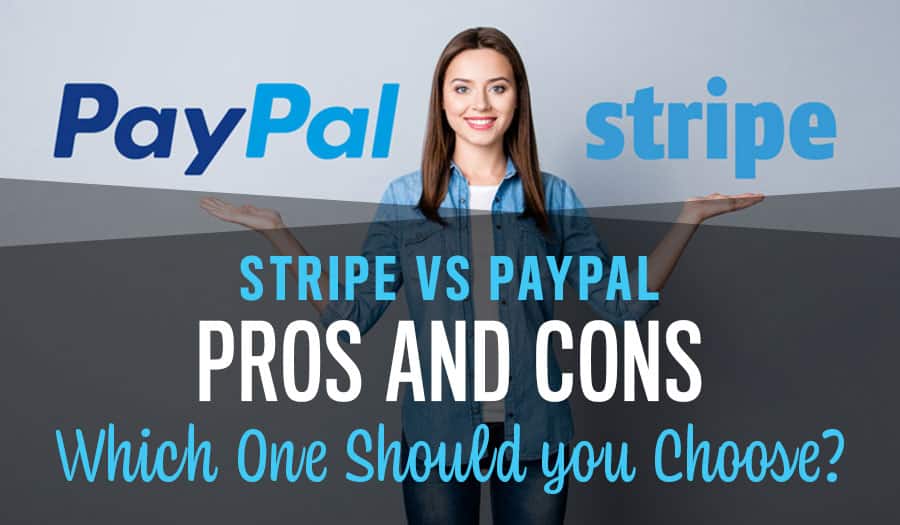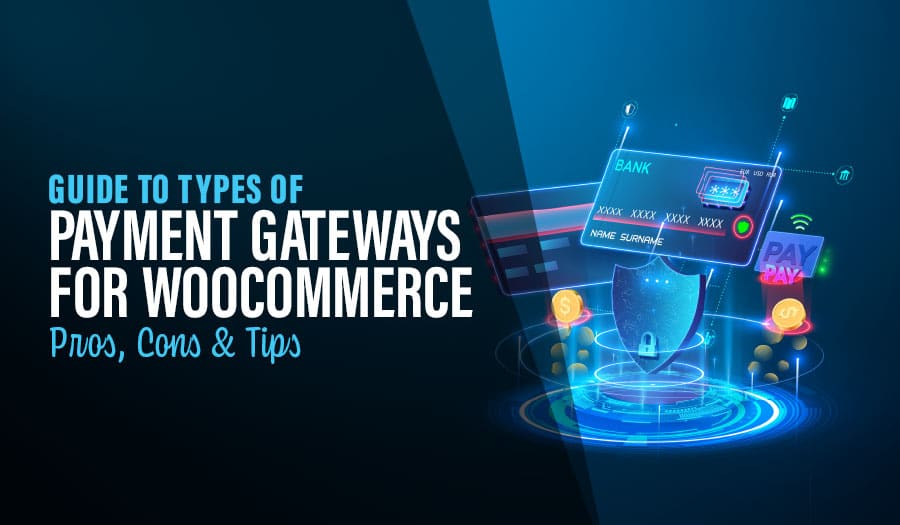Stripe and Paypal are the significant players in selecting a payment gateway for your business. Both offer similar benefits and have comparable fees, but there are some significant differences between the two. Let’s explore Stripe vs PayPal: Pros and Cons. Which One Should you Choose?
It is worth taking the time to consider all the factors when choosing how to accept online payments. After all, as an online merchant, the decision about how you will take payments is one of the most significant decisions you will have to make.
Introduction to Stripe and PayPal
What is Stripe, and how does it work as a payment gateway?
Stripe is an online payment platform that allows customers to pay merchants directly through debit and credit cards. It’s easy to integrate with various eCommerce sites, including websites built on popular platforms like WordPress or Shopify.
Stripe has grown tremendously over the last few years, with more than seven million users. It is now accepted in 25 countries and processes payments in 135 currencies. Stripe also offers additional services, such as fraud prevention and invoicing solutions.
What is PayPal, and how does it work as a payment gateway?
PayPal is one of the most popular payment solutions, allowing customers to pay merchants quickly and securely. It is easy to integrate with many eCommerce sites, including websites built on popular platforms such as WordPress or Shopify. PayPal also offers additional services such as fraud prevention and invoicing solutions.
The company has existed since 1998 and is now accepted in more than 200 countries. With PayPal, users can send payments using their bank account, credit card, or debit card. They also have the option to pay with their PayPal balance. For merchants, accepting payments via PayPal helps reduce their fraud risk while providing customers with an easy checkout experience.
Plus, merchants get access to tools that help them manage their business, including analytics and reporting. In addition, PayPal offers a variety of ways to customize the checkout experience, such as adding custom logos, colours and messages. PayPal is an excellent option for businesses looking for an easy and secure way to accept payments online.
Let’s take a closer look at Stripe and Paypal to see which would be the better choice for your e-commerce business:
Stripe vs PayPal: Which One Should you Choose?
Stripe
Stripe Pros
- Stripe is pretty uncomplicated – they are a payment gateway singularly focused on handling payments for you. They process credit card payments and also offer more payment options than PayPal, such as echecks, debit cards from all major companies, ECH and EFT transfers, Apple Pay, Android Pay and Bitcoin.
- Stripe offers API integrations, so you need not rely on their internal reporting. They offer official plugins for WordPress, Joomla, Drupal, and Magento, among others and have dedicated libraries for platforms built on Laravel, Ruby, React Native, Vue, Angular and many more.
- Many major corporations use Stripe, so while you may not know Stripe’s name as well as you do PayPal’s, Stripe is trusted by many big names you will recognise, such as UnderArmour and Facebook.
- Stripe offers fraud protection and customer support in multiple languages.
- Stripe has no setup costs or monthly fees, making it a great option for businesses starting out on their payments journey.
Stripe Cons
- The set-up process for Stripe is not as easy as PayPal – not by a long shot. Firstly, Stripe requires your site is totally SSL protected – which, let’s face it, it should be anyway – and if you need help ensuring your site is locked down by SSL so we can organise that for you. Next, there’s the fact Stripe involves some API key juggling. If you use WordPress, there are loads of plugins to help you with this. However, you will need to read carefully through the documentation and procedures.
- Stripe is not available worldwide. Nevertheless, Stripe is expanding their network. As Australia is one of their supported countries, Australian businesses can take payments from anywhere.
- Stripe does not offer any kind of dispute resolution. If a customer has an issue with a transaction, they will have to contact you directly and you’ll need to work out a solution. This can be quite time-consuming and can be the source of some frustration for both business owners and customers.
- Stripe charges processing fees for every transaction. This means that if you’re doing a lot of sales, it can add up quickly and become expensive. To keep costs low, make sure to look into different pricing structures and find the one that works best for your business.
PayPal
PayPal Pros
- One of the most recognised and trusted payment platforms on the internet, PayPal is also one of the oldest.
- Customers with an existing PayPal account can press one button to pay, which makes PayPal payments quick and easy at the customer’s end.
- PayPal is the default payment method for more than just a few ecommerce solutions and many plugins (which makes it a better choice and quick and easy on your end!).
- PayPal has tried and tested dispute settlement processes and offers a myriad of buyer and seller protections.
- PayPal’s analytics, reports and other useful tools are easy to find in the PayPal dashboard – and the data is easy to export, too.
- PayPal is just about everywhere, accepted in 25 different currencies and available in over 200 countries meaning people are very familiar with PayPal Payment.
PayPal Cons
- As we’ve said, PayPal is just about everywhere; however, a minority of people still resist it. Some want to make their purchase using a credit card – without being directed to another website- while others do not want to set up a PayPal account. If PayPal payments is your only payment option, you may lose these customers.
- PayPal requires you link out to them so that the customer can pay on the PayPal platform and afterwards, the customer will be redirected back to your store. Sometimes these redirects will be interrupted, which puts the sale at risk while it’s in the all-important endzone.
- PayPal is fantastic for payments made via credit cards and bank accounts. However, it does not allow for Apple Pay, Android Pay or cryptocurrency payments such as Bitcoin. If PayPal cannot secure it, it isn’t an option – which, while inconvenient for some, shows their unwillingness to compromise security.
Stripe vs Paypal fees in Australia
Stripe Merchant Fees
Stripe fees in Australia are 1.75% + 30c for all transactions, but if you’re using PayPal, you can expect to pay a higher fee of 2.4%-2.9% + 30c per transaction. This represents an additional cost to your small business that could be avoided by offering a range of payment options and allowing customers to choose their preferred method.
Furthermore, Stripe allows merchants to accept payments from various payment methods, including Visa, Mastercard, American Express, Discover and JCB cards, and Apple Pay and Google Pay for mobile phones. It also supports cryptocurrency payments such as Bitcoin. This gives customers more choices in how they pay for goods and services.
PayPal Merchant Fees
PayPal Merchant Fees in Australia vary depending on the transaction size but generally sit at 2.4%-2.9% + 30c per transaction. PayPal also offers the ability to accept payments to small businesses from various payment methods and a range of currencies, giving customers more options when paying for goods and services online.
Which is the better choice for my business: Stripe or PayPal?
Your e commerce customers will have their preferences no matter which one you choose, so to provide them with as many payment options as possible, why not use both?
Now, if the thought of using two different platforms and managing the payments from both already gives you a headache, you may opt for just one.
PayPal is your easy solution – it is simple, and standard with most platforms, and you can get paid immediately. Stripe, on the other hand, is the answer if you require a fully-integrated payment system, and although more complicated to get going, runs dependably and silently in the background.
If you are still uncertain, you can go ahead and compare the features of Stripe vs. PayPal at a glance here. Online merchants can also ask how PayPal stacks up against a Merchant Bank Account, you can read more about that here.
The types of businesses that generally use PayPal include freelancers, startups, non-profits and smaller companies. Stripe is favoured by larger enterprises, growing medium-sized businesses and companies that sell only online. Generally speaking, companies that choose to use both are eCommerce businesses, marketplaces, and WordPress agencies.
Choosing to start with one doesn’t rule out adding the other at a later stage. For example, PayPal can be your quick solution for adding a payment gateway today, while Stripe integration can be added later if you choose to.
If you are looking for help with your ecommerce site or want to meet for a chat to discuss how to grow your business, contact us today.
Incorporating Stripe and Paypal into WooCommerce
Integrating these two payment platforms can transform your eCommerce website. With these two payment gateways, you can build robust payment solutions for a wide range of customers including those who prefer PayPal and those who prefer to pay with their credit/debit cards using Stripe.
With both payment gateways integrated into your WooCommerce store, you can also offer a host of additional features like subscription payments, recurring payments, and more.
That said, setting up either PayPal or Stripe requires some technical knowledge.
We understand how hard it is to choose the right payment solution for your business. That’s why Pixelfish is here to help – we provide customised advice and support in selecting the best combination of Stripe and PayPal plugins to integrate into your eCommerce store.
We understand that each business is unique, so we can tailor our solutions to suit the specific needs of your business. Our team of experts will work with you every step of the way to ensure that your payment processing system is secure and efficient.
Most Widely used Payment Gateways
According to recent statistics, here are some of the most widely used payment gateways worldwide as of 2021:
- PayPal: PayPal is the most widely used payment gateway globally, with more than 300 million active users in 2021. It supports transactions in over 200 countries and regions and accepts payments in over 100 currencies.
- Stripe: Stripe is a popular payment gateway that offers customizable payment options, subscription billing, and fraud detection services. It is used by more than 1 million businesses worldwide and is available in over 40 countries.
- Square: Square is a payment gateway that offers mobile payment solutions, point-of-sale systems, and online payment processing. Millions of businesses in the United States, Canada, Japan, Australia, and the United Kingdom use it.
- Amazon Pay: Amazon Pay is a payment gateway that allows users to use their Amazon account to make payments on third-party websites. It is available in several countries, including the United States, the United Kingdom, Germany, France, Italy, Spain, Japan, and India.
- Adyen: Adyen is a payment gateway offering payment processing, risk management, and optimization services. It is used by over 5,000 businesses worldwide and supports transactions in over 150 currencies.
- Apple Pay: Apple Pay is a mobile payment and digital wallet service provided by Apple. It allows users to make payments from their iPhone, iPad, Mac, or Apple Watch. It is available in the United States, Australia, Canada, China, Japan, Singapore, Switzerland and the United Kingdom.
- Google Pay: Google Pay is a mobile payment and digital wallet service provided by Google. It allows users to make payments from their Android or Chrome devices, or from web browsers. It is available in the United States, India, Ireland, Japan, Poland and the United Kingdom.
- Eway: Eway is a payment gateway provider that offers merchant solutions, fraud protection, risk man
- Bank Merchant Accounts: A Bank Merchant Account is a payment solution offered by banks that allows businesses to accept customer payments via credit, debit, and other electronic payment methods. It is available in Australia, the United States, Canada, Europe, Asia and Latin America.
** Please note that these statistics are subject to change, and other payment gateways may be more widely used in specific regions or industries.
Other PayPal and Stripe FAQ’s
Can you use PayPal and Stripe in your WordPress Website?
Yes, PayPal and Stripe are both supported payment gateways for WordPress websites. Both provide merchant accounts that link to your website so customers can make payments. They offer a range of features, including fraud protection, an easy checkout process, and customizable payment forms. Additionally, they are widely accepted in multiple countries worldwide and allow businesses to accept payments from various currencies. PayPal and Stripe also provide detailed analytics that allow you to track, analyze, and optimize your online transactions. With these solutions, businesses can easily monitor and manage their payments in one place. Furthermore, both payment gateways offer secure payment options to ensure customers’ financial information is safe and protected.
Can you use PayPal and Stripe to take payment via Gravity Forms?
Yes, both PayPal and Stripe can be used to take payment via Gravity Forms. Both offer plugins that allow a Gravity Form to integrate with their payment gateway, allowing customers to submit payments through a secure form on your website. This process is also easy to manage and customize, ensuring you get the most out of this powerful ecommerce solution.
Can you use PayPal and Stripe to handle recurring payments?
Yes, both PayPal and Stripe offer recurring payment options. This means businesses can easily set up automated payments for their customers. PayPal’s subscription product allows businesses to take advantage of a streamlined checkout experience for customers, while Stripe offers simple yet powerful APIs that make it easy to manage recurring payments.
Can you use PayPal and Stripe to handle international payments?
Yes, both PayPal and Stripe offer international payment options. With PayPal, you can easily accept payments from customers around the world. Stripe’s global processing platform makes accepting payments in multiple currencies easy for businesses with a multi-national presence. Both services also provide fraud protection measures to help mitigate risk when doing business overseas.
What is the largest payment you can accept from PayPal and Stripe?
The maximum amount allowed per payment varies depending on the method of payment. PayPal’s maximum limit is $10,000 USD or its equivalent in other currencies if accepted through their international payment gateway. Stripe also has different limits for different types of payments but offers a maximum limit of $50,000 USD or its equivalent in other currencies for its direct debit payments. Stripe’s MegaCharge feature offers higher limits for businesses with larger transaction volumes.
Can you use PayPal and Stripe in Australia?
Yes, both PayPal and Stripe can be used for payments in Australia. However, payment limits may vary depending on the payment type.
Are there any fraud protection measures to help mitigate risk when doing business overseas?
Yes, both PayPal and Stripe provide security measures to help protect against online fraud. PayPal’s fraud protection includes data encryption, advanced fraud filters, buyer and seller protection policies, and secure payment methods. Stripe also offers a range of security measures such as tokenization, 3D Secure authentication, dynamic descriptor settings, and fraud detection algorithms. Additionally, both companies offer dispute resolution services that allow businesses to resolve customer complaints quickly and efficiently.
Does PayPal or Stripe over live chat or phone support?
Yes, both PayPal and Stripe offer customer service support through email, phone, and live chat. With PayPal’s 24/7 customer service team, you can get help with account issues or answer questions about their services. Stripe also provides 24/7 customer support via email and phone and a dedicated chatbot to help with any issues.
Both PayPal and Stripe offer extensive documentation that covers topics from setting up accounts to troubleshooting payment issues. Additionally, they both have a variety of helpful tutorials on their websites that can help customers better understand their services. Lastly, both companies provide integrated support with popular e-commerce platforms such as Shopify and WooCommerce.
Take your online store business to the next level and get started with a Pixel Fish Ecommerce Website.
Check out some of our latest Ecommerce Website Design projects.
More Reading
5 Great Tips for Improving Your organic Google Ranking
The 3 Keys to Writing Copy for Websites
8 Proven Successful Online Store Product Types
What is Inbound Marketing and how does it work?
How can SEO help my business?
Top 8 Advanced WordPress Features and Plugins to Beat Your Competition
Facebook Reviews vs LinkedIn Reviews vs Google My Business Reviews



